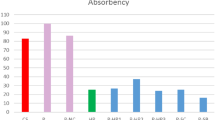Abstract
This work evaluated two combinations of additives, i.e. “carbon black and hindered amine light stabilizer (HALS)” and “carbon black and vitamin E” to prevent photodegradation of poly(butylene adipate-co-terephthalate) (PBAT) aiming its application as mulch films. A 22 factorial rotatable central composite design (α = 1.414) with three central points was conducted. Five different concentrations for each additive were used (0.1, 0.5, 1.0, 1.5 and 2.0% in mass). The formulations were exposed in an environmental simulator to radiation and condensation cycles. The both combination did not avoid the gel formation but its action reduced PBAT chain scission process during photodegradation. Nevertheless, comparing the two different combinations with carbon black, HALS additive was more efficient than vitamin E to minimize the reduction on tensile strength and elongation. The chain scission and crosslinking processes were evaluated by chain scission distribution function. The chain scission was the predominant process during photodegradation of pure PBAT and it was possibly favored by hydrolysis during condensation cycles in the accelerated aging test. It was verified that higher concentrations of carbon black in the formulations led to a reduction on light transmission in both experimental designs. Considering the responses of studied factors on mechanical properties and light transmission it was possible to identify the most promising formulations for application in mulch films, which correspond to 1.5% (weight) for each additive.






Similar content being viewed by others
References
Kyrikou J, Briassoulis DJ (2007) J Polym Environ 15:125
Touchaleaumea F, Martin-Closas L, Angellier-coussy H, Chevillard A, Cesar G, Gontard N, Gastaldi E (2016) Chemosphere 144:433
BASF (2015) https://www.basf.com/cn/en/company/news-and-media/news-releases/cn/2015/08/ecovio.html. Accessed 22 March 2018
Bilck AP, Grossmann MVE, Yamashita F (2010) Polym Test 29:471
Kijchavengkul T, Auras R, Rubino M, Ngouajio M, Fernandez RT (2008) Chemosphere 71:94
Kijchavengkul T, Auras R, Rubino M, Ngouajio M, Fernandes RT (2008) Chemosphere 71:1607
Kijchavengkul T, Auras R, Rubino M, Selke S, Ngouajio M, Fernandez R (2011) Polym Degrad Stab 97:1929
Poveda PNS (2015) Effect study of calcium carbonate, titanium dioxide and zinc oxide nanoparticles on linear low density polyethylene and aliphatic—aromatic copolyester thermoplastics properties subjected to ultraviolet radiation, PhD Thesis. Nuclear and Energy Reseach Institute, University of São Paulo
Dufton P (1998) Functional additives for the plastic industry. Rapra Technology Limited, Shrewsbury, p 284p
Hodgson JL, Coote ML (2010) Macromolecules 43:4573
Klein E, Lukes V, Cibulkova Z (2005) PetCoal 47:33
Lamont W (1995) In: Lamont W (ed) Production of vegetables, strawberries, and cut flowers using plasticulture. NRAES, Ithaca, pp 9–14
Shlyapintokh V (1984) Photochemical conversion and stabilization of polymers. Hanser, New York, p 484
Basf. Ecoflex F, Blend C (2004) São Paulo (commercial catalog)
Basf (2010) Tinuvin 783. São Paulo, (commercial catalog)
Cabot (1988) Carbon blacks for specialty applications, (commercial catalog)
American Society for Testing Materials (2012) ASTM G 154: standard practice for operating fluorescent ultraviolet (UV) lamp apparatus for exposure of nonmetallic materials
Felisberti MI, Sanchez EMS, Saron C (2016) Simulador ambiental para envelhecimento acelerado de polímeros, 04/2016, Patente de Invenção, PI0200366-0. Patente Unicamp, Depósito: 07/02/2002, Concessão: 26/04/2016. INPI—Instituto Nacional da Propriedade Industrial, Brazil
Galegário FF, Amaro M, Weihmann CR, Sanhueza RMV, Freire JM, Amarante CVT, Santos HP, Bender RJ, Palombini MC, Protas JFS, Coutinho EF (2015). Colheita e pós-colheita. https://sistemasdeproducao.cnptia.embrapa.br/FontesHTML/Morango/MesaSerraGaucha/colheita.htm. Accessed 29 Dec 2016
Passos FA (2013) Como plantar morango. http://revistagloboruralglobo.com/vidanafazenda/comoplantar/noticia/2013/12/como-plantar-morango.html. Accessed 22 Feb 2016
Tiba C, Fraidenraich N, Moskowicz M, Lyra FJM, Nogueira AMB, Gallegos HG (2000) Atlas solarimétrico do Brasil: banco de dados solarimétricos. Universitária da UFPE, Recife, p 111
Wolf R, Tüzun; B, Tüzun Y, Y. Sunscreens (2001) Dermatol Ther 14:206
Canevarolo SV (2000) Polym Degrad Stab 709:71
Stloukal P, Verney V, Commereuc S, Rychly J, Matisova-Rychlá V, Koutny M (2012) Chemosphere 88:1214
American Society for Testing and Materials (2012) ASTM D 882: standard test method for tensile properties of thin plastic sheeting
Pinheiro LA, Chinelatto MA, Canevarolo SV (2004) Polym Degrad Stab 86:445
Gensler R, Pummer CJG, Kausch H-H, Kramer E, Pauquet J-R, Zweifel H (2000) Polym Degrad Stab 67:195
Kale G, Auras R, Singh SP (2006) J Polym Environ 14:317
Lyu S, Schley J, Loy B, Lind D, Hobot C, Sparer RD, Untereker D (2007) Biomacromolecules 8:2301
Lucas EF, Soares BG, Monteiro EEC (2001) Caracterização de polímeros: determinação de peso molecular e análises térmicas. E-papers Serviços Editoriais, Rio de Janeiro, p 365
Kijchavengkul T (2010) Design of biodegradable aliphatic aromatic polyester films for agricultural applications using response surface methodology, PhD Thesis. School of packaging, East Lansing, MI: Michigan State University
EN 13655 (2002) Plastics. Mulching thermoplastic films for use in agriculture and horticulture
Brewer SA (2004) In: Charvat RA (eds) Coloring of plastics. Wiley, Hoboken, pp 159–174
Robertson GL (1993) Food packaging: principles and practice. Marcel Dekker Inc, New York, p 676p
Acknowledgements
The authors are grateful to FAPESP (Process Number 2016/11199-0 and 2016-10777-0) by the financial support.
Author information
Authors and Affiliations
Corresponding author
Rights and permissions
About this article
Cite this article
Souza, P.M.S., Morales, A.R., Sanchez, E.M.S. et al. Study of PBAT Photostabilization with Ultraviolet Absorber in Combination with Hindered Amine Light Stabilizer and Vitamin E, Aiming Mulching Film Application. J Polym Environ 26, 3422–3436 (2018). https://doi.org/10.1007/s10924-018-1229-0
Published:
Issue Date:
DOI: https://doi.org/10.1007/s10924-018-1229-0




